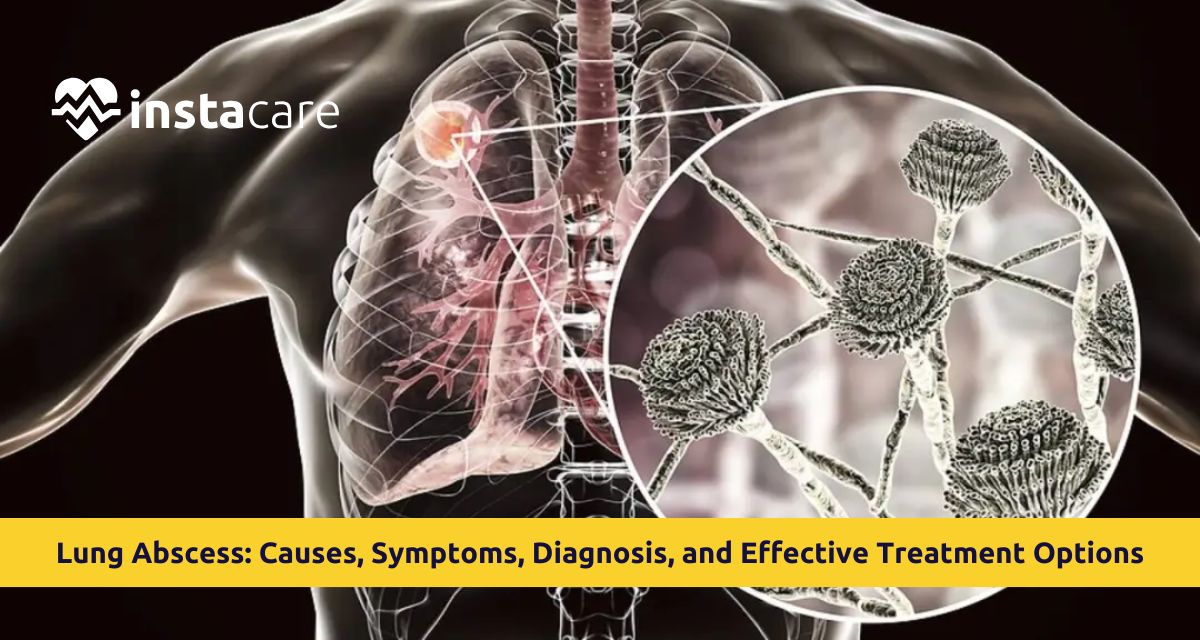What Is a Lung Abscess?
Lung abscess is a walled-off bacterial infection of pus in lung parenchyma secondary to tissue necrosis and bacterial infection. Lung abscess pathophysiology involves invasion by bacteria with pulmonary inflammation, tissue destruction, and cavity formation. Lung abscess is acute (less than six weeks duration) or chronic lung abscess (six weeks or longer duration).
Common Causes and Risk Factors
The most common etiologies of lung abscess are aspiration, leading to lung abscess due to aspiration of gastric or oral secretions into the airway. This is particularly more common in neurologic disease,
dysphagia, or altered mentation. The most common etiology of bacterial lung abscess is from oral anaerobic bacteria like Peptostreptococcus, Staphylococcus aureus, Klebsiella pneumoniae, and Bacteroides.
Severe risk factors are:
- Alcoholism
- Seizure disorder
- Stroke
- Periodontal disease
- Immunocompromised condition
- Esophageal disease
- Tumor obstruction
Signs and Symptoms of Lung Abscess
Clinical presentation of lung abscess usually comes about in weeks. Lung abscess symptoms include chronic productive cough with purulent sputum and foul odor, pyrexia and rigor, pleuritic chest pain, significant weight loss, weakness, hemoptysis, dyspnea, and foul breath odor. In lung abscess vs pneumonia, differential signs are slow progressive deterioration, foul sputum, and for longer duration in lung abscess.
How Is a Lung Abscess Diagnosed?
Lung abscess diagnosis involves a process of clinical evaluation, imaging studies, and laboratory testing. Definitive diagnosis is necessary to plan proper therapy and to rule out other pulmonary disease.
- Imaging Tests: The Chest X-ray will typically show an air-fluid level cavity in the majority, but early abscesses will appear as dense consolidations. The CT scan lung abscess radiology findings is more specific and shows the location, size, and relationship to adjacent structures of the cavity. CT is particularly useful to help differentiate lung abscess from empyema or other cavitary disease.
- Laboratory Tests: The blood would most typically be anticipated to have the increased white cell count and inflammatory markers. Sputum cultures detect the causative organism, and hence the antibiotic of choice. With systemic involvement, the blood cultures could be positive.
- Bronchoscopy: Bronchoscopy can be utilized to directly sample the abscess, to rule out bronchial obstruction, and to rule out malignancy, particularly in the carcinoma lung risk group.
Read More: What is Lung Cancer? Types, Symptoms, Causes, Threats, and Treatment
Treatment Options of Lung Abscess
Lung abscess treatment is generally long-course antibiotic treatment, and at times other treatment needs to be administered. Based on the size of the abscess, etiologic pathogen, and status of the patient, the treatment is administered.
Antibiotic Treatment
Lung abscess antibiotics are the mainstays of treatment. Empiric therapy for initial treatment generally covers anaerobes and aerobic bacteria. Suspicion for generally used regimens is clindamycin, beta-lactam/antipseudomonal beta-lactamase inhibitor combinations like ampicillin-sulbactam or carbapenems. Treatment duration generally is four to eight weeks depending on clinical improvement and radiographic response. Intravenous antibiotics typically are initiated initially and then subsequently may be switched to oral treatment after clinical improvement.
Drainage Methods
In medical treatment failure as an absolute last resort or with large abscesses, lung abscess drainage is indicated alone. Percutaneous CT-guided drainage is a procedure that is not invasive where direct drainage of pus without surgery is possible. The method can be used in abscesses greater than six centimeters or nonresponsive abscesses to antibiotics alone.
Surgical Management
Never done in straightforward cases, i.e., suspected malignancy, failure of medical treatment, or massive hemoptysis. Operations are lobectomy or pneumonectomy based on distribution of pulmonary involvement.
Supportive Management
Proper fluid intake, diet, and chest physiotherapy facilitate recovery. Postural drainage and breathing exercises facilitate mobilization of secretion and ventilation.
Possible Complications of Lung Abscess
Complications of lung abscess are alarming and fatal if not treated on time. Empyema (pus accumulation in the pleural space), bronchopleural fistula, and hemoptysis due to erosion of vessels are the common complications. Systemic complications include sepsis, hematogenous seeding with brain abscess, and acute respiratory distress syndrome. The lung abscess prognosis has been significantly enhanced by antibiotics but is very poor in immunocompromised patients or with late treatment. Chronic lung abscess can produce bronchiectasis, chronic cough, and recurrent infection. Early treatment and proper treatment also enhance outcomes and reduce complication rates.
Prevention and Self-Care Tips
Prevention of lung abscess occurs through management of modifiable risk factors and overall respiratory status. Oral hygiene and daily dental check-up is a required preventive intervention, as is the management of periodontal disease. Those patients with dysphagia require appropriate assessment and management, such as food consistency modification as appropriate.
Lifestyle modifications also intervene:
- Limitation of alcohol use
- Sedative avoidance when feasible
- Management of underlying illness such as gastroesophageal reflux disease
- Appropriate medication and prevention of seizure safety hazards to avoid aspiration attacks
The immunocompromised individuals must be adequately immunized with pneumococcal and flu vaccines. They must also stop smoking since smoking kills the lung's own protective mechanism. Proper positioning and strict adherence to aspiration precaution protocols by hospitalized or critically ill individuals prevent harm to themselves.
Self-resolution is the full course of antibiotics, proper fluid intake, respiratory maneuvers, and complete follow-up visits. The patient must be assessed for escalation of symptoms and referred directly to the emergency department if he or she has a worsening dyspnea, hemoptysis, or fever.
Conclusion
Lung abscess is a very severe respiratory infection that merits early diagnosis and aggressive therapy. Identification of the numerous causes of lung abscess, ranging from aspiration syndromes to infection, is facilitated so prevention and earlier treatment can be instituted. Classic presentation of lung abscess, such as fetid sputum and intractable fever, should be warning signs to both patient and clinician. Imaging studies, particularly CT scanning, facilitate accurate diagnosis and evaluation of therapeutic efficacy in lung abscess.
Please book an appointment with the
best Pulmonologist in Lahore, Karachi, Islamabad, and all major cities of Pakistan through
InstaCare, or call our helpline at 03171777509 to find the verified doctor for your disease.

